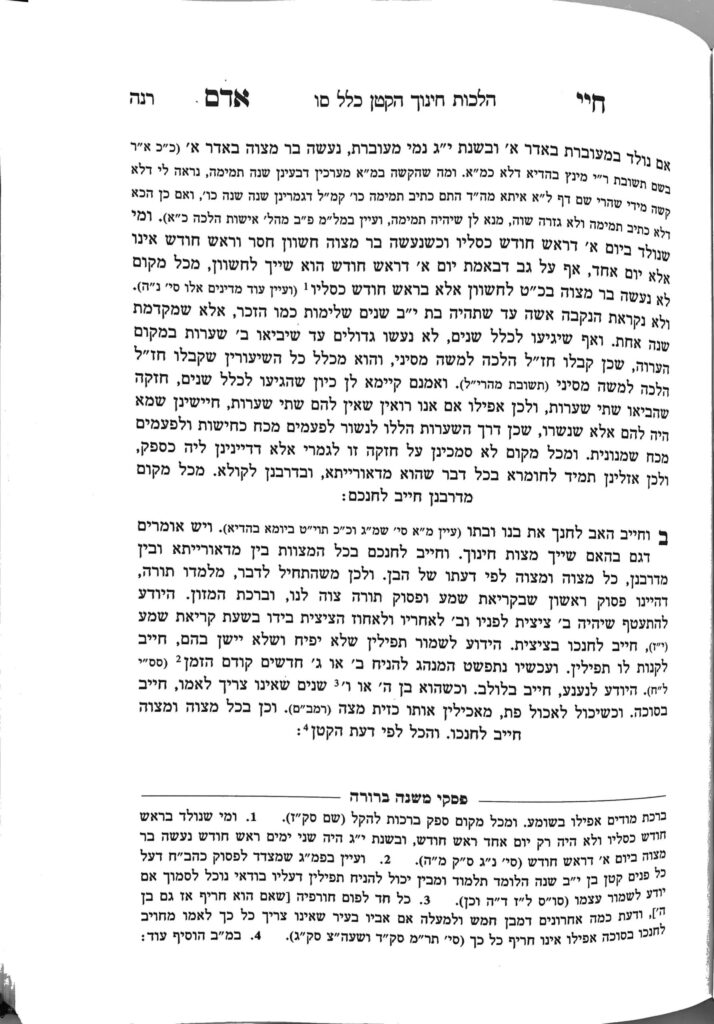We are continuing in siman 2. The Chayei Adam writes that the parents’ chiyuv applies to all mitzvos deoraysa and derabanan. The parents’ chiyuv is to train the child to do what they are supposed to do as an adult, therefore chinuch includes both mitzvos deoraysa and derabanan.
The Chayei Adam writes that each mitzvah takes effect at the time that the child is ready for it. As we have learned (shiur 1263), the training is to teach the child how to do the mitzvah properly. If the child does not yet have the skills to learn how to perform the mitzvah properly, there is no mitzvah of chinuch, and the effects can even be counterproductive
The Chayei Adam lists some examples of the proper age to begin chinuch in specific mitzvos:
- From the age the child can speak, the father has a chiyuv to teach the child torah: the first pasuk of shema, the pasuk of torah tzivah lanu moshe, and birkas hamazon. It is interesting to note that the Chayei Adam lists birkas hamazon under limud torah; it is not clear to me why he does so.
- From the age that a child can wear tzitzis properly, the father has a chiyuv to teach the child how to wear tzitzis.
We learned in hilchos tzitzis that the Beis Yosef understands that the appropriate way to wear tzitzis is with two of the strings in the front and two in the back. The Beis Yosef uses this to explain why there was a certain garment worn in Egypt during his time which did not receive tzitzis, even though it was a rectangle. Since all four corners were placed in front, the minhag was to refrain from placing tzitzis on it. We learn from the Beis Yosef that the proper way to wear tzitzis is in this manner.
The only exception to this rule is during krias shema, where many have the minhag to hold the tzitzis together. Some have the minhag to kiss them as well, but the primary minhag is to hold them, because it is proper to hold them while talking about them. Kissing the tzitzis is an added minhag which developed as a way to demonstrate our love for the mitzvah.
According to the Gra, one should only hold the front two tzitzis during krias shema. According to everyone else, one should hold all four tzitzis, moving the back corners to the front. We can understand why the Gra holds to only hold the front two: if we are talking about the mitzvah of tzitzis, it does not make sense to wear the tzitzis in an incorrect manner.
Either way, once a katan understands how to follow these procedures, they should begin to wear tzitzis.
- From the age that a katan is able to wear tefillin properly–that is, not to pass gas or fall asleep while wearing them–the father has a chiyuv to purchase tefillin for the child. However, the Chayei Adam writes that the minhag has become to wait until two or three months before the child’s bar mitzvah to give them tefillin, because wearing them with the proper thoughts of kedusha is not easy for a child. Although many have the minhag to wait until a month before the bar mitzvah, we see from the Chayei Adam that there is no specific amount of time one should begin before their bar mitzvah. Thus, if a slightly earlier or later date makes more sense (such as for grandparents to be present), one may do so.
Similarly, the Piskei Mishnah Berurah quotes from the Pri Megadim and Biur Halacha that a child who is involved in limud hatorah all day should begin wearing tefillin from the age of 12. Again, we see that there is no hard and fast rule, and whenever a child is ready and it is appropriate for them to begin wearing tefillin, they may do so.
Summary
The parents’ chiyuv chinuch applies to all mitzvos, deoraysa and derabanan, at the appropriate times that a child is ready to perform them properly. The Chayei Adam gives three examples:
- Torah: from when a child is able to speak;
- Tzitzis: from when a child is able to keep the tzitzis strings positioned properly, and follow the correct procedure for shema;
- Tefillin: from when a child is able to wear them with the appropriate kedusha. However, nowadays we wait until the weeks before a child’s bar mitzvah.



